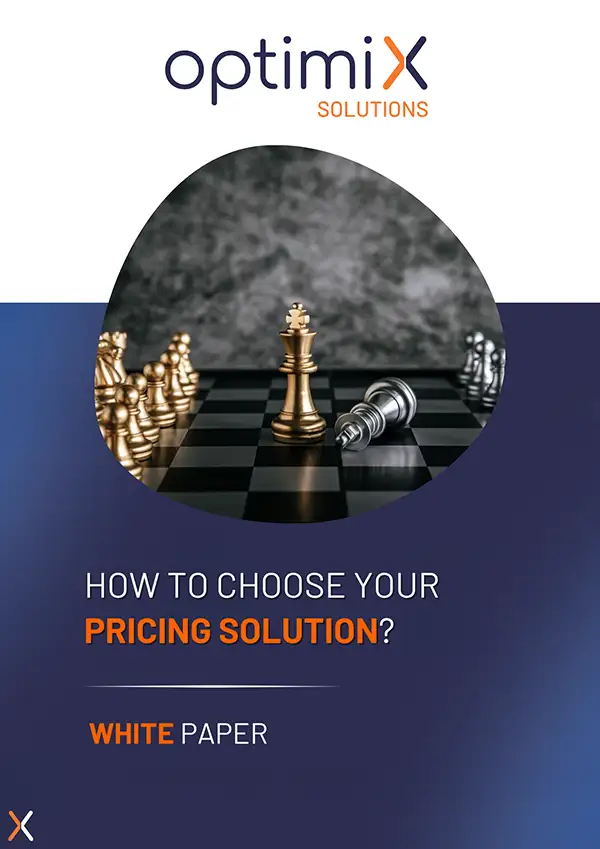Pricing, or pricing strategyis the art of setting the right price for a product or service. But it’s not simply a question of covering expenses or adding up a cost and a margin: pricing is a fundamental strategic lever.
It directly influences customer perception of value, pricing positioning, profitability and even market share. Mastering pricing means transforming a simple label into a lasting competitive advantage.
What is Pricing?
Pricing refers to all themethods used to establish an optimal selling price. The latter must enable the company to cover its costs (fixed and variable), while ensuring a sufficient margin. But beyond the economic equation, the price must remain consistent with the marketing mix, the sales strategy and the value perceived by customers.
A pricing policy not only responds to internal objectives, it must also adapt to market dynamics, consumer behavior and competitor pricing. In other words, pricing is a strategic management tool, at the crossroads of marketing, finance and operations.
Pricing: a lever for overall performance
Pricing is a key factor in a company’s overall performance. It has a direct impact on margins and profitability. Even a slight variation in price can generate a far greater net gain than a reduction in costs or an increase in volumes. In this respect, it represents a powerful optimization lever that is often under-exploited.
But the influence of pricing goes beyond the strict economic framework. It also plays a fundamental role in strategic positioning. A high price, when justified, reinforces an image of quality, rarity or expertise. Conversely, a low price can support a logic of volume, conquest or penetration strategy.
In all cases, price sends a signal to the market. To be effective, it must be consistent with the overall marketing mix and the expectations of the target segments. Poorly calibrated, it blurs the message. Well thought-out, it creates value.
How does an effective pricing strategy work?
One pricing strategy, based on a solid set-up. She is based on in-depth analysis, clear objectives and ongoing management.
It all starts with market and demand research: understanding customers’ needs, their price sensitivity(elasticity), and the perceived value of the offering. Then comes internal analysis, including costs, target margins and brand positioning.
A successful strategy also relies on segmentation: different groups of customers may have different expectations and willingness to pay, which makes it possible to adapt the pricing offer.
Competitive intelligence remains a benchmark, but the price must above all reflect the value provided rather than simply align with it.
To find out more, read our article : the essential steps for implementing a pricing strategy
Unified, differentiated and hybrid pricing: what's the difference?
Pricing is at the heart of sales strategy, and the choice of pricing model has a direct impact on competitiveness and profitability. There are three main approaches: unified, differentiated and hybrid.
Unified pricing: all customers pay the same price, regardless of channel, location or segment. This method guarantees consistency and transparency, reinforcing customer confidence. It is often used to simplify communication and preserve brand image.
Differentiated pricing: prices vary according to channel, market, customer segment or even time of purchase. This strategy maximizes revenues by adapting to willingness to pay and to local or sectoral specificities.
Hybrid pricing: combines both approaches. For example, maintaining the same base price across all channels while applying targeted adjustments for certain segments or periods.
The choice of model depends on the company’s objectives, cost structure, customer behavior and competitive dynamics. Properly mastered, it becomes a powerful lever for optimizing margins and adapting to the market.
To find out more, read our article : The pros and cons of each pricing strategy
which pricing solution to use to manage your pricing strategy?
Implementing an effective pricing strategy doesn’t just rely on intuition or competitive analysis: it requires structured tools capable of processing vast volumes of data, modeling scenarios and optimizing every pricing decision.
XPA – Optimix Pricing Analytics, our AI-enabled solution , embodies this 360° approach by integrating, in a single platform, all the functionalities needed to design, test and execute a high-performance pricing policy:
Intelligent pricing: adjust prices according to demand, inventory, product life cycle or customer buying behavior.
Advanced simulation: margin modeling, multi-segment management, identification of psychological thresholds and calculation of price elasticity.
Fine segmentation: adapting prices according to the perceived value and price sensitivity of each segment.
Strategic scenarios: test different hypotheses to assess their impact before implementation.
Seamless integration: connect with your CRM and customer data platforms (CDP) for ultra-personalized pricing.
Other dynamic pricing solutions, particularly in e-commerce, are also exploiting AI for pricing based on countless parameters: demand, customer behavior, seasonality or external context.
With XPA, this algorithmic power is natively integrated, while maintaining 100% human control to guarantee strategic coherence and business relevance. business relevance.
The benefits of a pricing solution
Adopting a pricing solution is essential to transforming your price management into a real lever for performance and competitiveness.
First of all, you save precious time and improve your productivity by automating pricing adjustments. No need to spend hours manually analyzing data or updating your pricing grids: the system takes care of this for you, freeing you up for higher value-added, more strategic tasks.
Among key benefits of a pricing solutioninclude :
Faster, more reliable decisions, thanks to optimal use of data and robust predictive models.
Reduced decision-making risk, by eliminating “blind” choices and basing each adjustment on factual analysis.
Directly improve profitability, by optimizing margins in each market segment and maximizing the impact of each pricing action.
How pricing transforms the performance of purchasing departments
Long confined to cost control, the purchasing function is evolving towards a more global approach, now integrating pricing as a performance lever. By cross-referencing sales price, elasticity and margin data, buyers are no longer content to simply optimize expenditure: they are becoming key players in profitability.
This broader approach makes it easier to strike the right balance between immediate savings and long-term profitability, while reinforcing the coherence between sales strategy and procurement policy.
Read the full article on : How pricing impacts the performance of purchasing departments
Different pricing models: between data and flexibility
In the digital age, pricing strategies have diversified. Freemium offers a free version with paying options, the subscription model ensures recurring revenues, while yield management adjusts prices in real time according to demand, seasonality or distribution channels.
Some companies go even further, adopting personalized pricing based on segments or purchasing behavior. These practices are increasingly accessible thanks to customer data and marketing automation tools, which make it possible to define dynamic prices while maintaining a coherent marketing strategy.
Pricing optimization through A/B testing
Price optimization can be greatly improved by using A/B testing. Far from relying on intuition, this method enables decisions to be made based on concrete data. By testing different pricing schemes or promotions on targeted market segments, a company can accurately measure customer reaction.
The results of these tests reveal which pricing structures maximize revenues, increase sales volume or improve the perception of value.
A/B testing is an agile approach that enables you to refine your pricing strategy on an ongoing basis, ensuring that each adjustment is justified by actual consumer behavior and contributes directly to profitability.
To find out more, please read our full article: Pricing optimization through A/B testing
How does pricing optimize price management on Marketplaces?
Price management on marketplaces is no longer limited to setting a price and waiting for sales. Pricing has become an essential strategic tool for the visibility and profitability of your products. In the face of fierce competition and connected consumers, agility is the key to staying competitive.
By exploiting real-time data, brands can adjust their prices in line with market fluctuations, buyer behavior, stock levels and competitor actions. This approach preserves margins while maximizing sales and meeting customer expectations.
Pricing has thus become a genuine management tool, integrated into sales strategies. It enables you to make informed decisions, anticipate market variations and remain competitive in the long term. In such a fast-moving environment, adopting an intelligent, automated pricing strategy is no longer an option for good price management on marketplaces, but a necessity.
Discover how to transform your marketplace price management with good pricing
Ethical and sustainable pricing: rethinking value beyond price
The ethical and sustainable pricing represents a modern, responsible approach that goes beyond simple profit maximization. It’s about rethinking value to include social and environmental considerations in pricing strategy.
This involves proposing prices that reflect the true cost of production, taking into account factors such as the fair remuneration of workers, the ecological impact of the materials used and the transparency of the supply chain. Rather than engaging in a price war, companies are adopting pricing based on customer-perceived value, valuing quality, sustainability and the brand’s ethical commitment.
By adopting ethical pricing, companies not only demonstrate responsibility. They also strengthen customer confidence and build a strong, respected brand image, creating lasting value for all stakeholders.
The impact of pricing on promotion and inventory management
Price management plays a central role in the balance between promotional policy and inventory management. Well thought-out pricing becomes a powerful lever for maximizing your margins while streamlining logistics flows.
Good pricing starts with perfectly aligned pricing and promotion strategies. Instead of offering random discounts, it helps you determine the ideal time, the products to target and the right discount level to stimulate demand and clear excess stock without eroding your margin.
What’s more, by analyzing your customers’ price elasticity and purchasing behavior, you can anticipate the impact of a price variation on sales volumes. This anticipation is crucial for guiding your supplies, reducing the risk of overstocking or shortages, and promoting smoother management of your flows.
Pricing, when integrated with inventory management, acts as a warning indicator, enabling you to adjust prices to accelerate the rotation of end-of-life products, or on the contrary, to maintain their perceived value in cases of scarcity.
For a more detailed analysis of this topic, we invite you to read our full article: How pricing impacts promotion and inventory management
Pricing, a strategic tool not to be underestimated
Setting a price is an operational necessity. But defining a pricing strategy is a strategic process. It requires data, a clear vision of the market, a detailed understanding of buying behavior, and a mastery of pricing tools. In a context of growing complexity, pricing becomes a differentiating factor in its own right, capable of supporting growth, optimizing sales margins and reinforcing corporate strategy.








